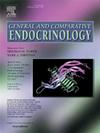Sex steroid profiles align with phenotype in sex-reversed female lizards
IF 1.7
3区 医学
Q3 ENDOCRINOLOGY & METABOLISM
引用次数: 0
Abstract
Vertebrate sex determination is remarkably diverse. In species with genetic sex determination, reproductive physiology and sex-specific behaviour are influenced by sex chromosomes and sex steroid hormones. However, some species experience sex reversal where the influence of sex chromosomes on sexual development is modulated by mutations or environmental conditions, leading to animals that phenotypically mismatch with their genotype. In these species, sex-reversed (‘discordant’) individuals can theoretically exhibit traits that are similar to either their phenotypic or genotypic sex. In the central bearded dragon (Pogona vitticeps), high incubation temperatures produce sex-reversed females with male-type sex chromosomes (ZZf). ZZf display a mix of male-like and intermediate traits compared to males (ZZm) and concordant females (ZWf). Sex steroid profiles could drive these differences but are yet to be examined in P. vitticeps. We measured testosterone (T) and estradiol (E2) in ZWf, ZZf, and ZZm dragons at three timepoints across a breeding season. As sex steroids can potentially affect offspring if maternal hormones are transmitted to eggs, we also compared T and E2 levels in egg yolks from ZZf and ZWf females. Sex-reversed ZZf had lower T levels than males and similar T and E2 levels to ZWf across the breeding season. ZWf and ZZf laid eggs with similar levels of T and E2. We found a negative association between maternal and yolk E2 levels, but no association between maternal and yolk T. Our results show that sex steroid profiles in sex-reversed ZZ female P. vitticeps reflect phenotypic, not genotypic sex, suggesting circulating sex steroids do not drive trait differences between discordant and concordant females.

性别逆转的雌性蜥蜴的性类固醇谱与表型一致。
脊椎动物的性别决定非常多样化。在遗传性别决定的物种中,生殖生理和性别特异性行为受性染色体和性类固醇激素的影响。然而,一些物种经历了性别逆转,其中性染色体对性发育的影响受到突变或环境条件的调节,导致动物表型上与其基因型不匹配。在这些物种中,性别反转(“不和谐”)的个体理论上可以表现出与其表现型或基因型性别相似的特征。在中央胡须龙(Pogona vitticeps)中,高温孵化产生性别反转的雌性,具有雄性型性染色体(ZZf)。与雄性(ZZm)和和谐雌性(ZWf)相比,ZZf表现出雄性和中间性状的混合。性类固醇谱可能会导致这些差异,但尚未在葡萄属植物中进行研究。我们在繁殖季节的三个时间点测量了ZWf、ZZf和ZZm龙的睾酮(T)和雌二醇(E2)。由于性类固醇可能会影响后代,如果母体的激素传递到卵子,我们也比较了ZZf和ZWf雌性蛋黄中的T和E2水平。在整个繁殖季节,性别反转的ZZf的T水平低于雄性,T和E2水平与ZWf相似。ZWf和ZZf产的蛋具有相似的T和E2水平。我们发现母系E2水平与卵黄E2水平呈负相关,但母系循环与卵黄t水平无相关性。我们的研究结果表明,性别逆转的ZZ雌性葡萄斑拟南藜的性类固醇谱反映的是表现型性别,而不是基因型性别,这表明循环性类固醇并不驱动不一致和一致雌性之间的性状差异。
本文章由计算机程序翻译,如有差异,请以英文原文为准。
求助全文
约1分钟内获得全文
求助全文
来源期刊

General and comparative endocrinology
医学-内分泌学与代谢
CiteScore
5.60
自引率
7.40%
发文量
120
审稿时长
2 months
期刊介绍:
General and Comparative Endocrinology publishes articles concerned with the many complexities of vertebrate and invertebrate endocrine systems at the sub-molecular, molecular, cellular and organismal levels of analysis.
 求助内容:
求助内容: 应助结果提醒方式:
应助结果提醒方式:


